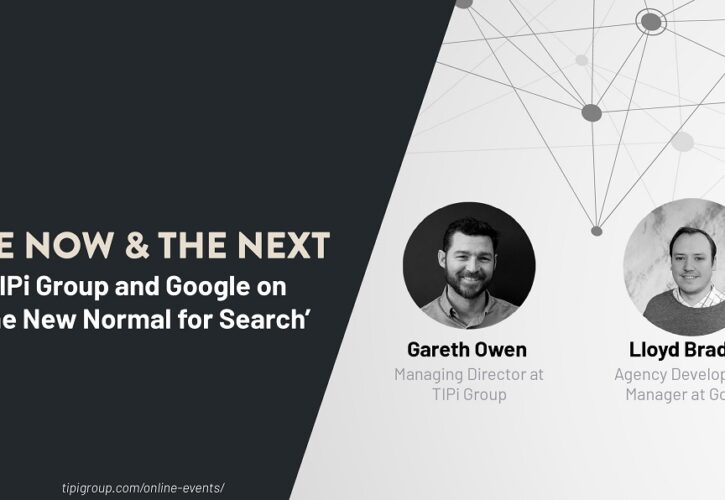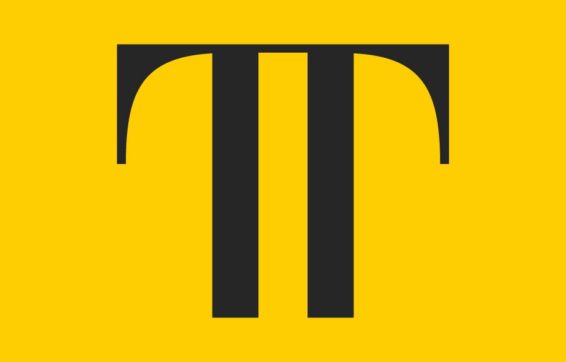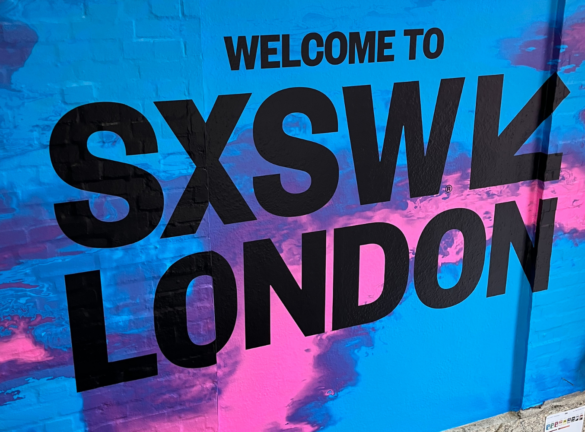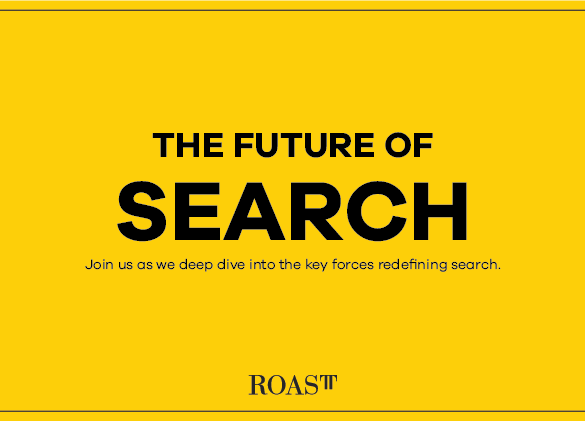
The Now & The Next: ‘The New Normal for Search’
On Wednesday, Gareth Owen, Managing Director at TIPi Group, sat down with Lloyd Bradley, Agency Development Manager at Google, to talk about the tremendous shifts the Search landscape has seen in 2020 and look a little further ahead to understand what Google are bringing to the table in the not too distant future.
A video of the session is available to watch here, and the key points are copied below.
Gareth Owen: How do you work with agencies at Google and how does this partnership benefit brands?
Lloyd Bradley: I work with Google’s Premier Partner Agencies, like TIPi Group, for instance, to provide them with exclusive access to events, the latest Betas and our newest technology. Our partnership guarantees agency teams are trained in tech as soon as it is released to ensure they can get the most value for every client pound spent in the platform, to drive ROAS and future investment. This is the main value – early and exclusive access to our knowledge, data and tools.
Also, our internal team of account strategists work as an extension of an agency’s team, as an additional arm to their business which they can leverage to brainstorm on strategy for accounts, discuss newly launched innovations on the platform, understand competitor performance and desired market share and address any campaigns that aren’t working to understand why.
GO: What’s your view on how COVID-19 has impacted Search across multiple verticals?
LB: The pandemic has accelerated shifts which were already underway, particularly in Omni-channel and eCommerce. We’re seeing huge winds in eCommerce for instance, which peaked at a 33% share this year – the highest ever. The digital world, in general, has been a lifeline for several businesses, things could have been much worse if they didn’t have access to online channels. Another interesting thing to note is that since the start of lockdown, 75% of consumers have tried new brands.
GO: The Highstreet has immensely suffered this year, what do you see happening in that space in the future?
LB: It’s obviously a very tough time for the Highstreet – those brands that already had a digital strategy in place or those that have been able to pivot, have been the ones that stayed afloat. Yet, there will always be a place for the Highstreet, it will bounce back. Despite accelerated eCommerce, people will always want the opportunity to go to a store and touch and feel things. However, innovation will continue to take place – I expect brands will be looking to recreate in-store experiences online as creatively as possible to emulate sensory experiences experienced in the flesh. For instance, we’ve seen real estate brands create virtual tours and automobile companies build virtual test drive simulations. These are some of the exciting things we’ve seen, yet we expect they’ll add to a brands marketing strategy, rather than directly replace old methods.
GO: As a business that went through the 2008 recession, what learnings can you give to us about how to tackle the 2020’s?
LB: It is widely known research, but I’ll echo it anyway. Those that increased their marketing spend during the 2008 downturn saw an 8% increase in profitability and a 4.3% increase during the recovery period as well. They also found that marketers who decreased profits saw an 0.8% drop when they cut marketing spend over a long period. The data points show that by completely pulling your marketing spend you are giving up a lot of share to your competitors and losing market share in the long term.
GO: How has the digital industry, and Google been affected as a result of the recession?
LB: Luckily, after the initial drop during the lockdown, we’ve seen growth in the last quarter. But, having said that, it is very vertical specific. Hospitality and travel for instance are still significantly decreasing investment which is understandable. But for other industries, digital channels offer flexibility that other platforms can’t. You have the power to change your budget daily, choose how much money you are willing to pay for someone to come to visit your site and so on. There is a place for you no matter how big or small you are.
GO: What do you think clients need to focus on for 2021?
LB: There are a few things brands need to have a lens on going forwards:
- Understanding which temporary trends will remain in place and which will revert back
- Moving away from third-party cookies to a more user first ecosystem where you have choice, transparency and control
GO: The more the user owns their data, the less insight & accuracy the advertiser has – how will eliminating third party cookies change the publisher, advertiser, user ecosystem?
LB: Looking at the advertising landscape, all three parties always have to be happy – the user, the publisher, the advertiser. Yet at the moment, one out of those three parties isn’t particularly happy, as seen through the rise of ad blockers and private viewings. To keep the ecosystem functioning, this move is vital. The move does present a lot of challenges, but the issue needs to be tackled head-on to keep the ecosystem functioning.
GO: Certain Search terms have recently been restricted for advertisers – what was the thinking behind this?
LB: The decision was again, privacy-based. Lately, Search behaviours have changed and we’re seeing more people search for longer tailed queries – they type exactly what they want, knowing that improved algorithms and machine learnings will find them what they need. This means we run the risk of being able to personally identify searches, so we’ve placed thresholds on search terms to ensure people are not able to be identified.
GO: With Google taking a lead in focussing on first-party data, is that going to help the industry?
LB: There is a lot of collaboration going on. This isn’t just a problem for Google or Facebook to solve, I think that everyone in this industry has tonnes of thought leadership going on about this and how the problem can be faced. A positive is the coming together of industry minds to fix this problem.
GO: Google’s ‘The “Messy Middle” of the Purchase Journey’ report focussed on how you can make sure someone clicks on your ad – have you seen much take up on that?
LB: We did a lot of research for the report into how user behaviour had changed and found that before a conversion happens, there are on average 140 touchpoints moving between brands, channel & platforms before that purchase action happens. We found that users don’t move in a linear fashion down the inverted triangle as per the traditional funnel model, in reality, it is more like a double circle, people are almost in flux until they come across the right brand that moves them from exploration phase into the purchase phase. Our tips were based on what makes your brand that trigger point and are summarised as:
- Category heuristics – This is how you describe your products, things you can call out in terms of USP’s and making people purchase your brand through things like callout extensions and site links. You need to build these in. Combine your data signals and selling points and what you know about your business with Google’s knowledge
- The power of the now – The longer that you have to wait for a product, the weaker the proposition becomes, with the likes of Amazon and next day delivery, time is a factor
- Social proof – Through reviews
- Scarcity bias – More desirability if harder to buy
- Authority bias – If you are swayed by an expert or a trusted source
So there are certain best practises you can add to your campaigns, but to navigate the current landscape you need to employ machine learning such as smart bidding, smart creatives and cross channel marketing through things like Google’s marketing platform. This is the key lever that you have to use to navigate the really complex consumer journey.
GO: With smart creatives, do they pull directly from these categories or do they work along different inputs of data?
LB: So for things like smart creatives, referring to responsive search ads or responsive display ads, essentially what that means is, there are a lot more options and combinations for how you can serve that ad. Outside of what the consumer is typing, machine learning models will be able to also see the individual’s age bracket, what they’re usually searching at this time of day if they were searching on YouTube yesterday and so on. This combination will be the best place to move this user out of the exploration phase and into purchase intent.
GO: What are the solutions in Beta that are going to be particularly important at this point?
LB: Touching back on the privacy issues and moving away from third-party cookies, all advertisers need to make sure they are using first-party tags as third party cookies are at a real risk of not being properly tracked now.
In terms of solutions that Google is working on to replace cookies, one is enhanced conversions, which will look at your first-party user data, whether that’s being uploaded from your CRM or you’re linking your fist party data directly into Google Ads and we can combine this with Google’s data. The other is consent mode, in which we’ll work on modelling users who have opted into cookies and compare this to users who have opted out and model your conversions on this so you can get a full picture of your marketing activity.
GO: Are Google taking the direction of using YouTube to push more awareness and using that to move more people into the funnel?
LB: YouTube can definitely be used as an awareness tool. The industry has seen a large rise in the use of video ads. Yet, YouTube is also seeing huge growth in its ‘for action’ product. It is a lower funnel platform that allows you to take your search data, (people who have searched for your brand and plug that into YouTube) and combine it with creatives, to direct people to a site.
GO: To round us off, what sorts of things do you think brands should be investing in next year?
LB: Data and Analytics is something that clients are looking for – how to responsibly use your data and strategies to target that audience. Another thing that is important is Marketing tech and creative – an umbrella that covers everything including data & analytics, audience activation technology, dynamic creative and overall automation. How you can connect your creative content, to technology, to allow you to optimise in real time around customer behaviour, with a lens on customer centricity – they are the things to watch next year.
To summarise, Data & Analytics – getting very savvy with that, using first-party data where possible and leveraging MarTech so you are able to use advancements in technology to target the right user, at the right time, with the right message.
Thank you for reading this wrap up of The Now & The Next: ‘The New Normal for Search’, if you would like to continue reading, why not dive into the B2B and B2C landscape.






